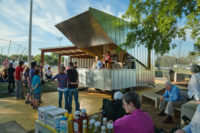Filmmaker Sam Wainwright Douglas on 'Citizen Architect' Samuel Mockbee of Rural Studio
Architects & Firms
Sam Wainwright Douglas was eight years old when he met architect Samuel Mockbee. The impression Mockbee made on Douglas was indelible.

Mockbee, affectionately called Sambo, was an iconoclastic figure in the field of architecture, best known for the Rural Studio, which he founded in 1993 in Hale County, Alabama — one of the state’s most impoverished areas.
Today, Douglas, 34, is a filmmaker whose recent documentary, Citizen Architect: Samuel Mockbee and the Spirit of the Rural Studio, has gotten favorable reviews for its candid portrayal of Mockbee’s commitment to the people of Hale County. The 60-minute film highlights the humanitarian role of architecture in education, communities, and social change.
How is it that you came to make a film about Samuel Mockbee and the Rural Studio?
My father was an architect, and Sambo would come from Mississippi to our house in Houston to see him when I was a kid. I got to spend time with Mockbee and we connected.
What did you think was so special about Sambo?
He had these sketchbooks that he would show me. They had magical creatures and fantastical-looking buildings that he had drawn. He was playful and clever, and he would encourage me to look at those books. I thought a lot about them.
You are now married to Sambo’s daughter, Sarah Ann. How did that happen? Did he have a hand in that, too?
Yes, he did. He was very intuitive. One day when I was still living in New York, Sambo called me and said, “You dating anybody? My daughter’s up there. Take down her number.” That was in 2001. We got married in 2007.
This is your second film as a director, and your first about architecture. How did it come about?
In 1996 I went down to the Rural Studio, which Sambo had started a few years earlier. Seeing the architecture in that setting blew me away. The students working on projects there were so charged and confident, and the architecture was so beautiful. Plus I knew what a great guy he was, and I thought, this could make a really moving documentary.
How did this independent film come to fruition?
I was in film school at New York University, and I kept thinking about the idea, and so in 1999 I interviewed Mockbee. He sat under his painting studio shed roof and just talked. I wasn’t a very good cameraman in those days, but I shot three hours of film. That is all I ever got of him.
What happened?
When Sambo died in 2001, I was just starting out in the film world, and I wasn’t anywhere with the project.
Yet I felt motivated to do it. At his funeral I met Jay Sanders, an architect who was mentored by Sambo at the Rural Studio. We said right there, we gotta do this film for Sambo.
Given that you had lost the central character of your film, how did you proceed?
First I was incredibly grief-stricken: He had introduced me to his daughter only three months earlier. When I got back around to thinking about the film, I felt that the three-hour interview was substantial enough to give a sense of his presence. It would be a way to have him explain his motivation and tell his story in his own words.
In the film, you focus on the building of the house for Music Man [Jimmie Lee Matthews]. Why did you choose that house?
During filming, in 2002 and 2003, Jay Sanders’s class was working on this project. And yes, Music Man is an affable, generous, and charismatic guy with an extremely engaging presence on film. I knew he’d be great to be work with, and I could tell that a bond between him and the students was quickly forming. It was a perfect combo.
What did you hope that people who know little about architecture, and nothing about the Rural Studio, would take away from your film?
Many people who see the film have nothing to do with architecture, but they leave inspired. I hope they think about how they can affect their community or solve a social problem with their gifts and talents. That’s what really attracted me to making this film in the first place: I was inspired by an architect who, in the face of seemingly overwhelming problems that challenge our world, found a place where he could use his skills and talents to do something about it in the best way he could.
Citizen Architect will be shown on March 17 at the National Building Museum in Washington, D.C. The filmmaker will be present for a Q&A.

